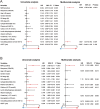Real-world prognostic significance of attaining minimal residual disease negativity in newly diagnosed multiple myeloma
- PMID: 38367151
- PMCID: PMC10874347
- DOI: 10.1007/s12672-024-00891-8
Real-world prognostic significance of attaining minimal residual disease negativity in newly diagnosed multiple myeloma
Abstract
The aim of the study was to evaluate the prognostic impact of minimal residual disease (MRD) in the real-world setting and the interaction between MRD and molecular risk, clinical response and autologous stem-cell transplant (ASCT). A retrospective analysis of 275 newly diagnosed multiple myeloma (NDMM) patients who achieved very good partial remission (VGPR) or better before maintenance were involved. We examined MRD status by multiparameter flow cytometry (MFC). At a median follow-up of 37 months (4-88 months), In patients who achieved ≥ VGPR, those with MRD negativity had significantly longer PFS (51 vs. 26 months; P < 0.001) and OS (Not reached: NR vs. 62 months, P < 0.001) than those with MRD positivity. MRD positivity was the independent prognostic factor for PFS with hazard ratios of 2.650 (95% CI 1.755-4.033, P < 0.001) and OS with hazard ratios of 2.122 (95% CI 1.155-3.899, P = 0.015). Achieving MRD negativity was able to ameliorate a poor prognosis associated with genetic high risk. MRD negativity was associated with better PFS regardless of ASCT treatment. MRD status was more predictable for clinical outcome than conventional clinical responses. Moreover, Sustained MRD negativity ≥ 12 or ≥ 24 months improved both PFS and OS. Patients with NDMM who achieved MRD-negative status or sustained MRD negativity had deep remission and improved clinical outcomes regardless of high-risk cytogenetics, ASCT and clinical responses in a real-world setting.
Keywords: Minimal residual disease; Multiple myeloma; Prognostic factor.
© 2024. The Author(s).
Conflict of interest statement
The authors declare that they have no competing interests.
Figures





Similar articles
-
[The prognostic significance of dynamic monitoring of minimal residual disease (MRD) status in patients with newly-diagnosed multiple myeloma].Zhonghua Xue Ye Xue Za Zhi. 2019 Jul 14;40(7):584-588. doi: 10.3760/cma.j.issn.0253-2727.2019.07.009. Zhonghua Xue Ye Xue Za Zhi. 2019. PMID: 32397022 Free PMC article. Chinese.
-
Achieving minimal residual disease-negative by multiparameter flow cytometry may ameliorate a poor prognosis in MM patients with high-risk cytogenetics: a retrospective single-center analysis.Ann Hematol. 2019 May;98(5):1185-1195. doi: 10.1007/s00277-019-03609-x. Epub 2019 Feb 5. Ann Hematol. 2019. PMID: 30721336 Clinical Trial.
-
Real-world advantage and challenge of post-autologous stem cell transplantation MRD negativity in high-risk patients with double-hit multiple myeloma.BMC Cancer. 2024 Apr 2;24(1):406. doi: 10.1186/s12885-024-12077-0. BMC Cancer. 2024. PMID: 38565996 Free PMC article.
-
A large meta-analysis establishes the role of MRD negativity in long-term survival outcomes in patients with multiple myeloma.Blood Adv. 2020 Dec 8;4(23):5988-5999. doi: 10.1182/bloodadvances.2020002827. Blood Adv. 2020. PMID: 33284948 Free PMC article.
-
Response rates and minimal residual disease outcomes as potential surrogates for progression-free survival in newly diagnosed multiple myeloma.PLoS One. 2022 May 12;17(5):e0267979. doi: 10.1371/journal.pone.0267979. eCollection 2022. PLoS One. 2022. PMID: 35550641 Free PMC article.
Cited by
-
Measurable Residual Disease Testing in Multiple Myeloma Following T-Cell Redirecting Therapies.Cancers (Basel). 2024 Sep 27;16(19):3288. doi: 10.3390/cancers16193288. Cancers (Basel). 2024. PMID: 39409909 Free PMC article. Review.
-
Cytogenetic risk stratification combined with minimal residual disease status influences the therapeutic outcome and prognosis of multiple myelomas.Sci Rep. 2025 Apr 12;15(1):12545. doi: 10.1038/s41598-025-97125-w. Sci Rep. 2025. PMID: 40217083 Free PMC article.
-
Real-World Evidence on Prognostic Value of MRD in Multiple Myeloma Using Flow Cytometry.Eur J Haematol. 2025 Jan;114(1):155-163. doi: 10.1111/ejh.14316. Epub 2024 Oct 10. Eur J Haematol. 2025. PMID: 39390851 Free PMC article.
References
Grants and funding
LinkOut - more resources
Full Text Sources
